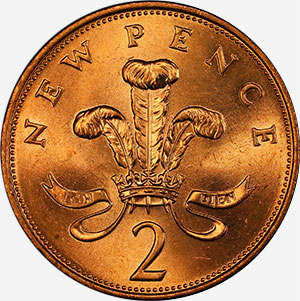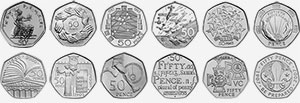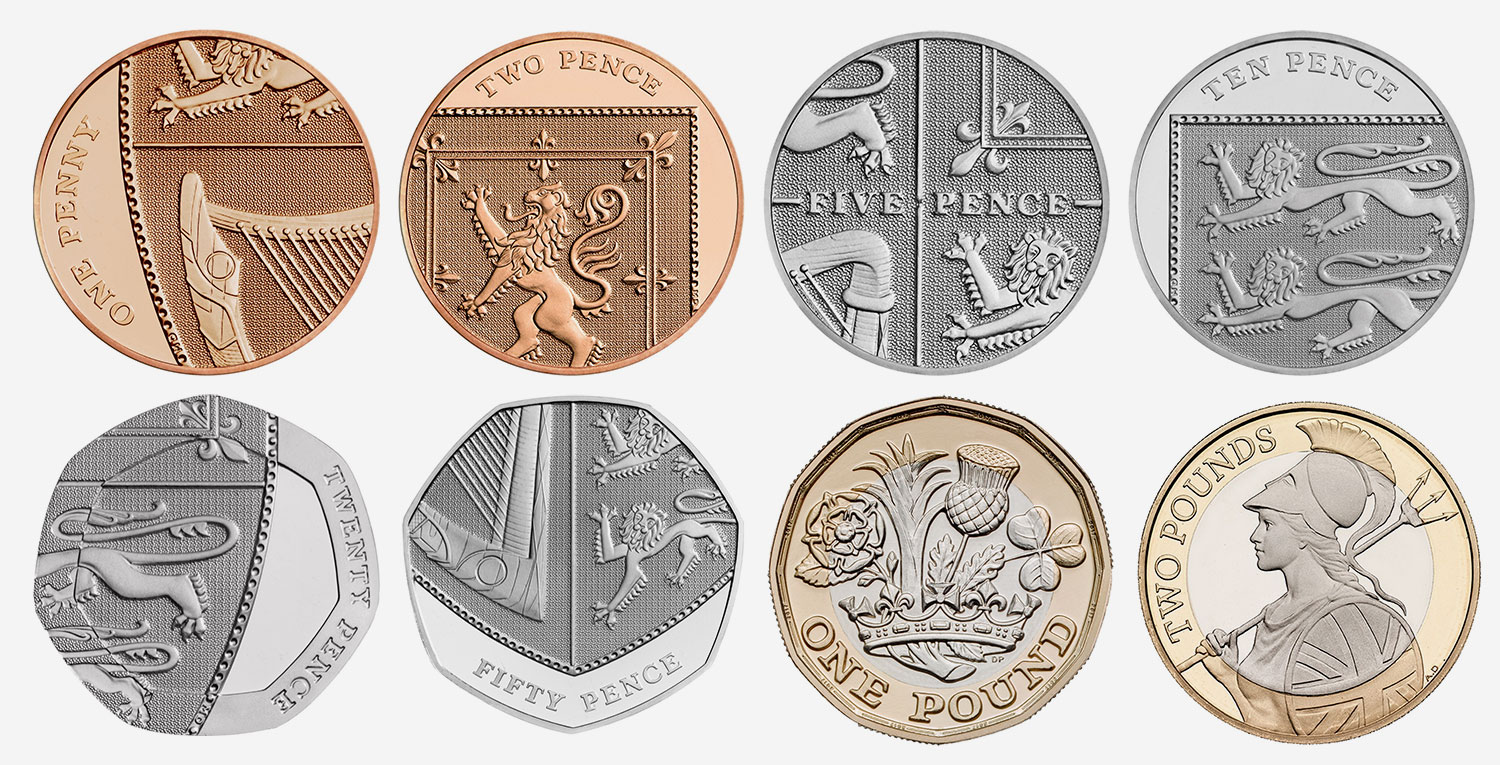Designs on British coins from 1971 to 2008
By thecanadiannumismatist | Monday, 8 January 2024
Before decimalisation, a pound equalled 20 shillings and each shilling was worth 12 pence. Working with a base unit of 12 made calculations quite difficult. Decimalisation began on February 15, 1971 (decimal day).
At the time, most countries around the world had decimal-based currencies. Since, the pound has been divided into 100 (new) pence. For the new denominations, the Royal Mint also commissions the coins' designs.
All coins showed a portrait of Queen Elizabeth II on the obverse.
Half Penny
The British decimal halfpenny coin was introduced in February 1971, but ignored in banking transactions. It became Britain's least favourite coin. The coin was demonetised and withdrawn from circulation in December 1984, even if The Treasury argued that this denomination was important against inflation, as it prevented prices from being rounded up. The design on the reverse of the coin is a representation of St Edward's Crown.
One penny
A crowned portcullis, heavy castle gate made of metal strips that form a grid often found in medieval fortifications, surrounded by chains was chosen.
The crowned portcullis has come to be accepted during the twentieth century as the emblem of both Houses of Parliament. Since 1967, the it has been used exclusively on House of Commons stationery. It replaced an oval device, which had been in use since the turn of the twentieth century, on the recommendation of the Select Committee on House of Commons.
It appears in the Henry VII Chapel in Westminster Abbey and other buildings connected with the Tudors such as King's College Chapel, Cambridge. In the Palace, it was certainly used, for example in the cloisters dating from 1526, where portcullises can still be seen in the ceiling bosses. It also appeared on the ceiling of the Star Chamber and, according to early nineteenth century authorities, in St Stephen's Chapel itself. A portrait of Sir Christopher Wray (Speaker in 1571) shows him wearing a chain of office in which the portcullis is prominently featured.
The portcullis appeared and was used at several other places and on multiple other occasions.
The United Kingdom 1p coin was one of three new coins introduced into general circulation on 15th February 1971, when the United Kingdom adopted a new decimal currency system. The other two new coins were the 1/2p and 2p coins.
The first copper-plated steel 1p coins were struck in 1992. The reason for this change was the increase in the price of metals on the world markets. The coins have a mild steel core and are electroplated with copper - consequently, they are magnetic.
Specifications
- Diameter: 20.3 mm
- Weight: 1.52 mm (Bronze), 1.65 mm (Copper-plated steel)
- Thickness: 3.15 mm
- Composition:
- Bronze (97% copper, 2.5% zinc, 0.5% tin) until September 1992
- Copper-plated steel since September 1992
- Edge: Plain
- Die axis: ↑↑
Two pence
The Badge of the Prince of Wales can be found on 1971 to 2008 two pence coins. It consists of a plume of ostrich feathers within a coronet, and above, the German motto ICH DIEN (I serve).
The emblem appeared and is still often used. The plume of ostrich feathers appears several times on Edward, the Black Prince (1330-1376) chest tomb in Canterbury Cathedral, alternating with his paternal royal arms. The Black Prince also used heraldic badges of one or more ostrich feathers in various other contexts.
Specifications
- Diameter: 25.9 mm
- Weight: 7.12 g
- Thickness: 1.85 mm (Bronze), 2.03 mm (Copper-plated steel)
- Composition:
- Bronze (97% copper, 2.5% zinc, 0.5% tin) until September 1992
- Copper-plated steel since September 1992, except in 1998 when the 2p was made in both alloys
- Edge: Plain
- Die axis: ↑↑
Five pence
The National emblem of Scotland, a thistle royally crowned was the design on the reverse of this denomination.
Common throughout the highlands, islands and lowlands of Scotland, the prickly purple thistle has been Scotland's national emblem for centuries. This proud and regal plant, which grows to a height of five feet, has no natural enemies because of the vicious spines that cover and protect it like a porcupine.
The first use of the thistle as a royal symbol of Scotland was on silver coins issued by James III in 1470.
With the introduction of the decimal coinage in 1971, the pre-decimal one shilling coin was re-denominated as a 5p coin and these old shilling coins continued to circulate alongside the 5p coin until 1990. After a review of the United Kingdom coinage in 1987, the Government announced its intention to issue a smaller 5p coin.
Specifications
- Diameter: 32.6 mm (large), 18 mm (small)
- Weight: 5.65 g (large), 3.25 g (small)
- Thickness: 1.7 mm (small)
- Composition: Cupro-nickel (75% copper, 25% nickel)
- Edge: Milled
- Die axis: ↑↑
Ten pence
The reverse of the coin, designed by Christopher Ironside was a crowned lion (formally, Part of the crest of England, a lion passant guardant royally crowned). A lion passant is walking, with the right fore paw raised and all others on the ground.
On the Royal arms of the United Kingdom, it is a lion statant. A lion statant is standing, all four feet on the ground, usually with the forepaws together. This posture is more frequent in crests than in charges on shields.
The smaller coin was issued on 30th September 1992.
Specifications
- Diameter: 28.5 mm (large), 24.5 mm (small)
- Weight: 11.31 g (large), 6.5 g (small)
- Thickness: 1.85 mm
- Composition: Cupro-nickel (75% copper, 25% nickel)
- Edge: Milled
- Die axis: ↑↑
Twenty pence
The Tudor rose (sometimes called the Union rose) is crowned on the reverse of this denomination. The Tudor rose is the traditional floral heraldic emblem of England and takes its name and origins from the House of Tudor, which united the House of Lancaster and the House of York. The Tudor rose consists of five white inner petals, representing the House of York, and five red outer petals to represent the House of Lancaster.
To help identification and avoid confusion with similar sized coins, the 20p is seven sided and, like the 50p, an equilateral curve heptagon. The shape, with its constant rolling diameter, means that it is readily acceptable in vending machines.
Specifications
- Diameter: 21.5 mm
- Weight: 5 g
- Thickness: 1.7 mm
- Composition: Cupro-nickel (84% copper, 16% nickel)
- Edge: Plain
- Die axis: ↑↑
Fifty pence
Britannia is featured on most of the fifty pence coin with, at her, the British Lion (also found on one of the most beautiful coin ever produced), an animal found on the arms of England, Scotland and the Prince of Wales. Britannia is a national personification of Britain as a helmeted female warrior holding a trident and shield.
By the 1st century BC, Britannia replaced Albion as the prevalent Latin name for the island of Great Britain. After the Roman conquest in 43 AD, Britannia came to refer to the Roman province that encompassed the southern two-thirds of the island.
In October 1969, 50p coins joined the 5p (shilling) and 10p (florin) coins in circulation, leaving only the three copper coins - to be introduced on 15 February 1971 - to complete the new series of decimal coins. With the introduction of smaller 5p and 10p coins in 1990 and 1992 respectively, 50p coins became the largest in circulation. In October 1994, the Government announced a further review of the United Kingdom coinage. The results revealed a requirement for a smaller 50p coin, which was duly introduced on 1 September 1997.
Designs
- 1969: Britannia.
- 1970: Britannia.
- 1973: The United Kingdom's Accession to the European Economic Community.
- 1976: Britannia.
- 1977: Britannia.
- 1978: Britannia.
- 1979: Britannia.
- 1980: Britannia.
- 1981: Britannia.
- 1982: Britannia.
- 1983: Britannia.
- 1984: Britannia.
- 1985: Britannia.
- 1986: Britannia.
- 1987: Britannia.
- 1988: Britannia.
- 1989: Britannia.
- 1990: Britannia.
- 1991: Britannia.
- 1992: The United Kingdom's Presidency of the Council of Ministers and the Completion of the European Single Market.
- 1993: Britannia
- 1994: The 50th Anniversary of the D-Day Landings.
- 1995: Britannia.
- 1996: Britannia.
- 1997: Britannia.
- 1998: The 50th Anniversary of the Creation of the National Health Service.
- 1999: Britannia.
- 2000: Britannia / The 150th Anniversary of the Public Libraries Act.
- 2001: Britannia.
- 2002: Britannia.
- 2003: Britannia / The 100th Anniversary of the Formation of the Women's Social and Political Union.
- 2004: Britannia / The 50th Anniversary of the First Four-Minute Mile by Roger Bannister.
- 2005: Britannia / The 250th Anniversary of Samuel Johnson's Dictionary of the English Language.
- 2006: Britannia / The 150th Anniversary of the Institution of the Victoria Cross.
- 2007: Britannia / The Centenary of the Foundation of the Scouting Movement.
- 2008: Britannia / The Royal Arms.
Specifications
- Diameter: 60 mm (large), 27.3 mm (small)
- Weight: 13.5 g (large), 8 g (small)
- Thickness: 1.78 mm
- Composition: Cupro-nickel (75% copper, 25% nickel)
- Edge: Plain
- Die axis: ↑↑
One pound
By 1980, it had become apparent, that with the general decline in purchasing power, the £1 unit of currency was more appropriate to a coin than a banknote. The note was in constant use and, on average, each note only lasted nine months. The new coin and design was issued on 21 April 1983.
To make it easy to identify, the round £1 coin was thicker than other coins, while its yellow colour allowed it to stand out from the cupro-nickel silver coins already in circulation. The weight of the coin was largely decided based on cost and the need to allow for higher denomination coins in due course.
Through the years, multiple reverse designs were used for this denomination.
Designs
- 1983: Royal Arms, representing the United Kingdom.
- 1984: Thistle and royal diadem, representing Scotland.
- 1985: Leek and royal diadem, representing Wales.
- 1986: Flax Plant and royal diadem, representing Northern Ireland.
- 1987: Oak Tree and royal diadem, representing England.
- 1988: Shield of the Royal Arms, representing the United Kingdom.
- 1989: Thistle and royal diadem, representing Scotland.
- 1990: Leek and royal diadem, representing Wales.
- 1991: Flax Plant and royal diadem, representing Northern Ireland.
- 1992: Oak Tree and royal diadem, representing England.
- 1993: Royal Arms, representing the United Kingdom.
- 1994: Lion Rampant, representing Scotland.
- 1995: Dragon passant, representing Wales.
- 1996: A Celtic cross, with a Pimpernel Flower in the centre, surrounded by an ancient Torc, representing Northern Ireland.
- 1997: Three Lions passant guardant, representing England.
- 1998: Royal Arms, representing the United Kingdom.
- 1999: Lion Rampant, representing Scotland.
- 2000 Dragon passant, representing Wales.:
- 2001: A Celtic cross, with a Pimpernel Flower in the centre, surrounded by an ancient Torc, representing Northern Ireland.
- 2002: Three Lions passant guardant, representing England.
- 2003: Royal Arms, representing the United Kingdom.
- 2004: A representation of the Forth Railway Bridge, inside a border of railway tracks.
- 2005: A representation of the Menai Bridge, inside a border of railings and stanchions.
- 2006: A representation of the Egyptian Arch Railway Bridge, inside a border of railway station canopy dags.
- 2007: A representation of the Gateshead Millennium Bridge, inside a border of struts.
- 2008: Royal Arms, representing the United Kingdom / Shield of the Royal Arms, representing the United Kingdom.
Specifications
- Diameter: 22.5 mm
- Weight: 9.50 g +/-0.260
- Thickness: 3.15 mm
- Composition: Nickel-Brass (70% copper, 5.5% nickel, 24.5% zinc)
- Edge: Milled
- Die axis: ↑↑
Two pounds
After a review of the United Kingdom coinage in 1994, it emerged that there was a requirement for a £2 coin to enter general circulation. A consultation process took place with the vending machine industry, members of the public and special interest groups, such as the RNIB and Age Concern. The consensus of opinion from the consultation favoured a bicolour coin, because it would be easily distinguishable from the other coins in circulation.
A new design was required for the reverse and it was decided that a competition, open to members of the general public, was the way to proceed. The winning artist, Bruce Rushin, an art teacher from Norfolk, based his design on a series of concentric circles telling the story, through symbolic devices, of technological development from the Iron Age to the Industrial Revolution and from the Computer Age to the internet.
An appropriate edge inscription had to be chosen before the recommended design could be submitted to the Chancellor of the Exchequer, and then to Queen Elizabeth II, for approval. The words that were eventually chosen were taken from a letter written in 1676 by Isaac Newton to his fellow scientist Robert Hooke, acknowledging the debt he owed to others: If I have seen further it is by standing on the shoulders of giants
Originally, the intention was to issue the £2 coin in November 1997 and millions of coins were struck with the Raphael Maklouf portrait of Queen Elizabeth II on the obverse in readiness for launch. Concerns, however, emerged from the vending industry prior to the issue date. Production was placed on hold, whilst further tests were carried out, and resumed in 1998, featuring the new portrait of Her Late Majesty by Ian Rank-Broadley on the obverse.
The £2 coin was eventually launched on 15 June 1998, when millions of both versions of the coin were released. Because of the two different portraits, however, many confusing stories have arisen. The most common misconception is that the £2 coin bearing the Raphael Maklouf portrait of the Queen, in which she is wearing a necklace, was made in very modest numbers. However, since millions of these coins were minted, this is simply not the case.
Designs
- 1997: The History of Technological Achievement.
- 1998: The History of Technological Achievement.
- 1999: The History of Technological Achievement / The 1999 Rugby World Cup.
- 2000: The History of Technological Achievement.
- 2001: The History of Technological Achievement / The 100th Anniversary of Marconi's 1st Wireless Transmission across the Atlantic.
- 2002: The History of Technological Achievement / The XVII Commonwealth Games in Manchester.
- 2003: The History of Technological Achievement / The 50th Anniversary of the Discovery of DNA.
- 2004: The History of Technological Achievement / The 200th Anniversary of the First Steam Locomotive by Richard Trevithick.
- 2005: The History of Technological Achievement / The 400th Anniversary of the Gunpowder Plot / The 60th Anniversary of the End of the Second World War.
- 2006: The History of Technological Achievement / The 200th Anniversary of the Birth of Isambard Kingdom Brunel.
- 2007: The History of Technological Achievement / The Tercentenary of the Act of Union between England and Scotland / The Bicentenary of the Abolition of the Slave Trade in the British Empire.
- 2008: The History of Technological Achievement / The Olympic Handover Ceremony in Beijing / The Centenary of the London Olympic Games of 1908.
In August 2005 the Royal Mint launched a competition to find new reverse designs for all circulating coins. The winner, announced in April 2008, was Matthew Dent, whose designs were gradually introduced into the circulating British coinage from mid-2008.
The beading was removed from both sides of the coin in the 2008 re-design. Each denomination shows a segment of the Royal Arms:













